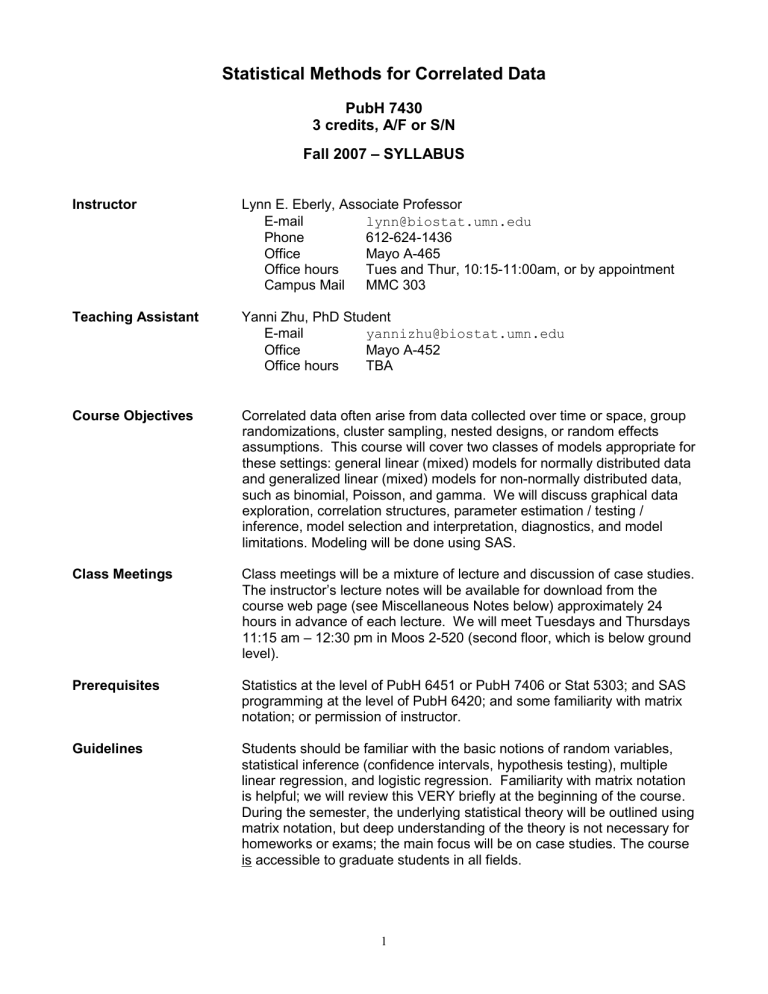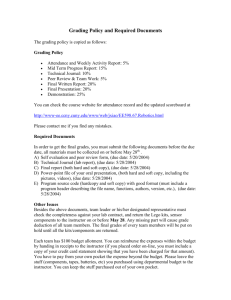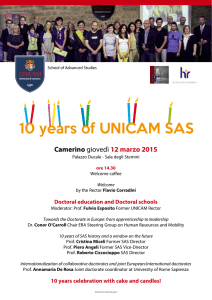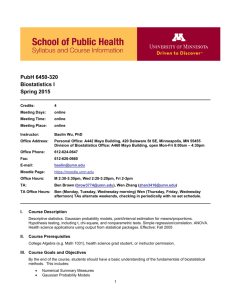Statistical Methods for Correlated Data

Instructor
Teaching Assistant
Course Objectives
Statistical Methods for Correlated Data
PubH 7430
3 credits, A/F or S/N
Fall 2007
– SYLLABUS
Lynn E. Eberly, Associate Professor
E-mail lynn@biostat.umn.edu
Phone
Office
612-624-1436
Mayo A-465
Office hours Tues and Thur, 10:15-11:00am, or by appointment
Campus Mail MMC 303
Yanni Zhu, PhD Student
E-mail yannizhu@biostat.umn.edu
Office Mayo A-452
Office hours TBA
Correlated data often arise from data collected over time or space, group randomizations, cluster sampling, nested designs, or random effects assumptions. This course will cover two classes of models appropriate for these settings: general linear (mixed) models for normally distributed data and generalized linear (mixed) models for non-normally distributed data, such as binomial, Poisson, and gamma. We will discuss graphical data exploration, correlation structures, parameter estimation / testing / inference, model selection and interpretation, diagnostics, and model limitations. Modeling will be done using SAS.
Class Meetings Class meetings will be a mixture of lecture and discussion of case studies.
The instructor’s lecture notes will be available for download from the course web page (see Miscellaneous Notes below) approximately 24 hours in advance of each lecture. We will meet Tuesdays and Thursdays
11:15 am – 12:30 pm in Moos 2-520 (second floor, which is below ground level).
Prerequisites Statistics at the level of PubH 6451 or PubH 7406 or Stat 5303; and SAS programming at the level of PubH 6420; and some familiarity with matrix notation; or permission of instructor.
Guidelines Students should be familiar with the basic notions of random variables, statistical inference (confidence intervals, hypothesis testing), multiple linear regression, and logistic regression. Familiarity with matrix notation is helpful; we will review this VERY briefly at the beginning of the course.
During the semester, the underlying statistical theory will be outlined using matrix notation, but deep understanding of the theory is not necessary for homeworks or exams; the main focus will be on case studies. The course is accessible to graduate students in all fields.
1
Required Materials One course packet of in-class case studies by the instructor and one book: Weiss (2005). Modeling Longitudinal Data , New York: Springer-
Verlag, Inc. ISBN 0387402713. Both are available at the Coffman Union
Bookstore.
Recommended Materials Verbeke and Molenberghs (2000). Linear Mixed Models for Longitudinal
Data , New York: Springer-Verlag, Inc. ISBN 0387950273. If you expect your future work to involve lots of longitudinal data analysis in SAS, this is a helpful book to own.
Computing All statistical modeling for in-class case studies will be presented in SAS.
Any student can request access to SAS on the Biostatistics computer
UNIX network. Students with access to SAS elsewhere are free to use whichever system is most convenient. A student one-year license is available from http://www1.umn.edu/adcs/software/individuals.html#stats .
SAS Version 9 or higher will be needed. Students more familiar with Stata or SPSS may use those, but the course staff cannot provide any support.
SAS documentation can be found at http://support.sas.com/documentation/onlinedoc/sas9doc.html
.
Graphing of data is also emphasized in this class, and can be done in the student’s package of choice; in-class case studies will use R, a free package (almost clone of S-Plus) available at http://www.r-project.org
.
Work Expectations Students are expected to attend class, participate in class discussions, and complete the assigned homeworks, exam, and project. Students are also expected to complete assigned reading from the required materials.
Homework There will be five homework assignments during the semester. We encourage you to work together in computing and discussing the problems. However, each student is expected to independently write up the submitted assignment using her or his own computing and giving explanations in her or his own words. All assignments will involve computing; please attach only relevant computer output to what you turn in. Some assignments may also include reading and writing about a related journal article.
You will get about two weeks to work on each homework assignment.
The homework will be graded on a scale of 0 to 10 points, for a maximum of 50 points possible over the semester. Late homework will lose three points per day, unless arrangements have been made with the instructor for an extension.
Exam There will be one in class open-book / open-notes exam towards the middle of the semester. The exam is worth 50 points.
Project There will be a final project worth 50 points towards the end of the semester (no final exam). The project could take one of two structures:
(1) Obtain a data set with a correlated structure; using relevant background information, determine several scientific questions to be answered by the data. Carry out a full analysis that addresses these
2
Grading
Outline scientific questions using any appropriate modeling strategies covered in class and discuss the results. A written report is required.
(2) Choose an area of correlated data analysis that is not covered in this course. Review and summarize the relevant literature. Or, carry out a simulation to demonstrate or explore a concept. A written report is required.
More details will be handed out in mid October. Each student must write a <1/2 page project proposal (by e-mail is fine) and get approval from the instructor by early November. We will have a few data sets available for option (1) and a few ideas available for option (2) if you do not already have something you would like to work on.
A letter grade will be determined from the percentage of (130 possible) points each student receives as follows:
B+ 87-89% C+ 77-79% D+ 67-69%
A 93-100% B 83-86% C 73-76% D 63-66%
A- 90-92% B- 80-82% C- 70-72% F 0-62%
For those enrolled S/N, a letter grade of C or better must be achieved to receive an S. The University Senate has established a uniform grading policy for all letter grades: www1.umn.edu/usenate/policies/ gradingpolicy.html
. If you would like to switch grading options (e.g.,
A/F to S/N), it must be done within the first two weeks of the semester.
Every section includes case studies. (Numbers) are the week numbers.
Introduction and some examples (week 1)
Graphical exploration of correlated data (1-3)
Matrix algebra and review of regression in matrix notation (2)
Classical methods for normally distributed repeated measures (3-4)
derived variables models
repeated measures analysis of variance
drawbacks and limitations of classical methods
Methods for normally distributed correlated data (4-12)
general linear (mixed) models
estimation / testing / interpretation / model building / diagnostics
“time-varying” covariates / parameterization issues
Review of methods for non-normally distributed independent data (13)
logistic regression
Poisson regression
Methods for non-normally distributed correlated data (13-14)
generalized linear mixed models
estimation / testing / interpretation / model building / diagnostics
generalized estimating equations (GEE)
estimation / testing / interpretation / model building / diagnostics
Advanced topics (time permitting) (15)
missing data issues
critiquing published research articles which use these methods
3
Resources Several books on background material and further references on the material we will cover are on reserve in the Bio-Medical Library Reserve
Desk (Diehl Hall 270):
(1) Diggle, Heagerty, Liang, and Zeger (2002). Analysis of Longitudinal
Data , London: Oxford University Press. For much more theoretical detail on all of the material we will cover.
(2) Davis (2002). Statistical Methods for the Analysis of Repeated
Measurements , New York: Springer-Verlag. For a bit more theoretical detail and similar application detail on all of the material we will cover.
(3) Neter, Kutner, Nachtsheim, and Wasserman (1996). Applied Linear
Statistical Models , 4 th Edition, Chicago: Irwin Press. For review of matrix algebra and regression in matrix notation (Chapter 5), regression techniques in general (Chapters 6-12), and logistic regression and Poisson regression (Chapter 14).
(4) Fitzmaurice, Laird and Ware (2004) Applied Longitudinal Analysis ,
New York: John Wiley and Sons.
In addition, the Biostatistics Reading Room (Mayo A-460) has full documentation for SAS Version 8, two books on graphing in SAS, and the following:
(1) Littell, Miliken, Stroup, and Wolfinger (1996). SAS System for Mixed
Models , Cary, NC: SAS Institute, Inc. For detailed examples using
SAS PROC MIXED .
(2) Khattree and Naik (1999). Applied Multivariate Statistics with SAS
Software , 2 nd Edition, Cary, NC: SAS Institute, Inc. For detailed graphing and modeling examples using SAS.
These cannot be checked out except to make copies, but can be browsed in the Reading Room.
Miscellaneous Notes Clarifications from class, changes in homework assignments, or course announcements will be distributed by e-mail to your University x500 account. Also, we will be maintaining a course web page at http://www.biostat.umn.edu/~lynn/ph7430.html
Lecture notes, homework solutions, previous years’ exams, some computing information and code, data sets, and office hours will be available there. At the end of the semester, please take seriously the opportunity to give feedback in the course evaluations and advise us on how the course might be improved.
The following policies are common to all courses in the School of Public Health and are mandated by the School’s Educational Policies document.
Grading Option Policy If applicable, students may change grading options during the initial registration period or during the first two weeks of the term. The grading option may not be changed after the second week of the term.
An incomplete grade is permitted only in cases of extraordinary circumstances and following consultation with the instructor. In such
4
cases, an “I” grade will require a specific written agreement between the instructor and the student specifying the time and manner in which the student will complete the course requirements. Extension for completion of the work will not exceed one year.
Scholastic Dishonesty Students are responsible for knowing the University of Minnesota Board of
Regents’ policy on student conduct and scholastic dishonesty: www1.umn.edu/regents/policies/academic/Student_Conduct
_Code.pdf
. Scholastic dishonesty as defined in the policy will be reported to the Office of Student Judicial Affairs: www.sja.umn.edu
and will result in a grade of “F” or “N” for the entire course.
Plagiarism is an important element of this policy. It is defined as the presentation of another’s writing or ideas as your own. Serious, intentional plagiarism will result in a grade of “F” or “N” for the entire course. For more information on this policy and for a helpful discussion of preventing plagiarism, please consult University policies and procedures regarding academic integrity: writing.umn.edu/tww/plagiarism/ .
Students are urged to be careful that they properly attribute and cite others’ work in their own writing. For guidelines for correctly citing sources, go to tutorial.lib.umn.edu
and click on “Citing Sources.”
In addition, original work is required in this course. It is unacceptable to hand in assignments for this course for which you receive credit in another course unless by prior agreement with the instructor. Building on a line of work begun in another course or leading to a thesis, dissertation, or final project is acceptable.
Withdrawal Policy
If you have any questions, consult the instructor.
School of Public Health students may withdraw from a course through the second week of the semester without permission. No “W” will appear on the transcript. After the second week, students are required to do the following:
1) The student must contact and notify their advisor and course instructor informing them of the decision to withdraw from the course.
2) The student must send an e-mail to the SPH Student Services Center
(SSC) at sph-ssc@umn.edu
. The email must provide the student name, ID#, course number, section number, semester, and year with instructions to withdraw the student from the course, and acknowledgement that the instructor and advisor have been contacted.
3) The advisor and instructor must e-mail the SSC acknowledging the student is canceling the course. All parties must be notified of the student’s intent.
4) The SSC will complete the process by withdrawing the student from the course after receiving all e-mails (student, advisor, and instructor).
A “W” will be placed and remain on the student transcript for the course.
5) After discussion with their advisor and notification to the instructor, students may withdraw up until the eighth week of the semester.
There is no appeal process.
5
It is University policy to provide, on a flexible and individualized basis, reasonable accommodations to students who have a documented disability (e.g., physical, learning, psychiatric, vision, hearing, or systemic) that may affect their ability to participate in course activities or to meet course requirements.
Students with disabilities are encouraged to contact Disability Services to have a confidential discussion of their individual needs for accommodation. Disability Services is located in Suite 180
McNamara Alumni Center, 200 Oak Street. Staff can be reached by calling (612) 626-1333 (V/TTY).
6








